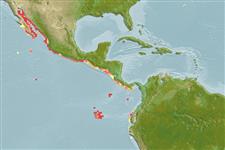Elasmobranquios (tiburones y rayas) (sharks and rays) >
Heterodontiformes (Bullhead and horn sharks) >
Heterodontidae (Bullhead, horn, or Port Jackson sharks)
Etymology: Heterodontus: heteros (Gr.), different; odontos (Gr.), tooth, referring to pointy teeth (for clutching prey) at front of jaws, different than rounded molar-like teeth (for grinding hard-shelled invertebrates) at the back. (See ETYFish); mexicanus: -anus (L.), belonging to: Mexico, referring to its distribution in the Gulf of California along the Mexican coast to at least Oaxaca (and perhaps to Peru). (See ETYFish).
Environment: milieu / climate zone / depth range / distribution range
Ecología
marino demersal; rango de profundidad 0 - 50 m (Ref. 54547). Tropical; 31°N - 18°S, 115°W - 80°W
Eastern Pacific: Mexico and from Costa Rica to Colombia, probably Ecuador and Peru (Ref. 43278)
Tamaño / Peso / Age
Maturity: Lm ? range ? - ? cm
Max length : 170 cm TL macho / no sexado; (Ref. 96339)
Found on littoral continental waters, on rocky and sandy areas from close inshore down to at least 20 m depth. Reported to reach 165 cm (Ref. 37955). Feeds on crabs and demersal fishes including midshipman (Porichthtys) (Ref. 43278). Oviparous (Ref. 37955). Utilized as fishmeal.
Life cycle and mating behavior
Madurez | Reproducción | Puesta | Huevos | Fecundidad | Larva
Oviparous (Ref. 50449). Distinct pairing with embrace (Ref. 205).
Compagno, L.J.V., 1984. FAO Species Catalogue. Vol. 4. Sharks of the world. An annotated and illustrated catalogue of shark species known to date. Part 1 - Hexanchiformes to Lamniformes. FAO Fish. Synop. 125(4/1):1-249. Rome, FAO. (Ref. 247)
IUCN Red List Status (Ref. 130435)
Threat to humans
Traumatogenic
Human uses
Pesquerías: pesquerías de subsistencia
Más información
ReferenciasAcuiculturaPerfil de acuiculturaRazasGenéticaElectrophoresesheritabilidadEnfermedadesProcesamientoNutrientsMass conversion
ColaboradoresImágenesStamps, Coins Misc.SonidosCiguateraVelocidadTipo de nataciónSuperficie branquialOtolitosCerebrosVisión
Herramientas
Special reports
Download XML
Fuentes de Internet
Estimates based on models
Preferred temperature (Ref.
123201): 20.6 - 26.9, mean 23.2 °C (based on 30 cells).
Phylogenetic diversity index (Ref.
82804): PD
50 = 0.5059 [Uniqueness, from 0.5 = low to 2.0 = high].
Bayesian length-weight: a=0.00380 (0.00166 - 0.00872), b=3.15 (2.95 - 3.35), in cm total length, based on LWR estimates for this (Sub)family-body shape (Ref.
93245).
Nivel trófico (Ref.
69278): 4.2 ±0.73 se; based on food items.
Resiliencia (Ref.
120179): Bajo, población duplicada en un tiempo mínimo de 4.5-14 años (Fec assumed to be <100).
Fishing Vulnerability (Ref.
59153): Very high vulnerability (90 of 100).
